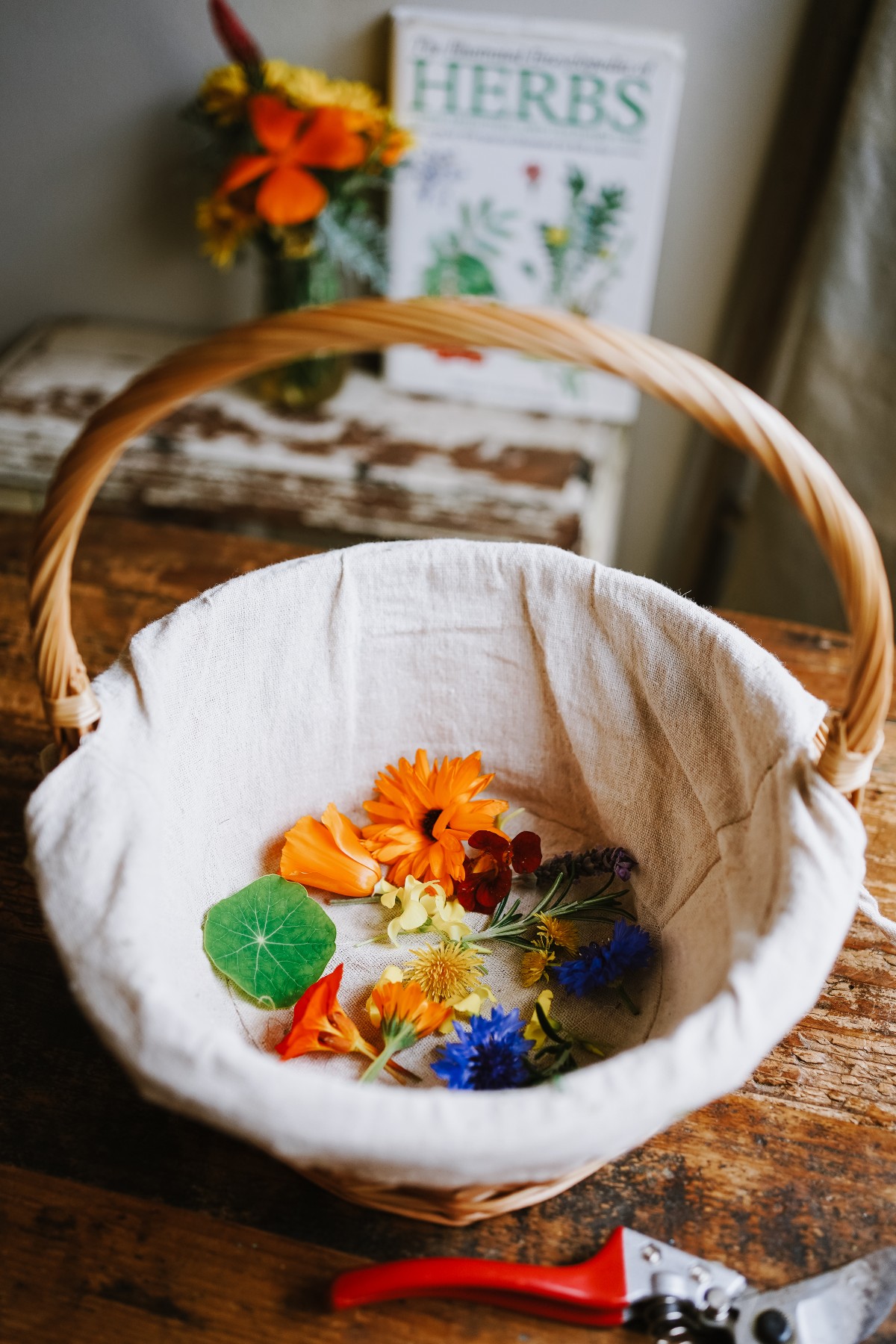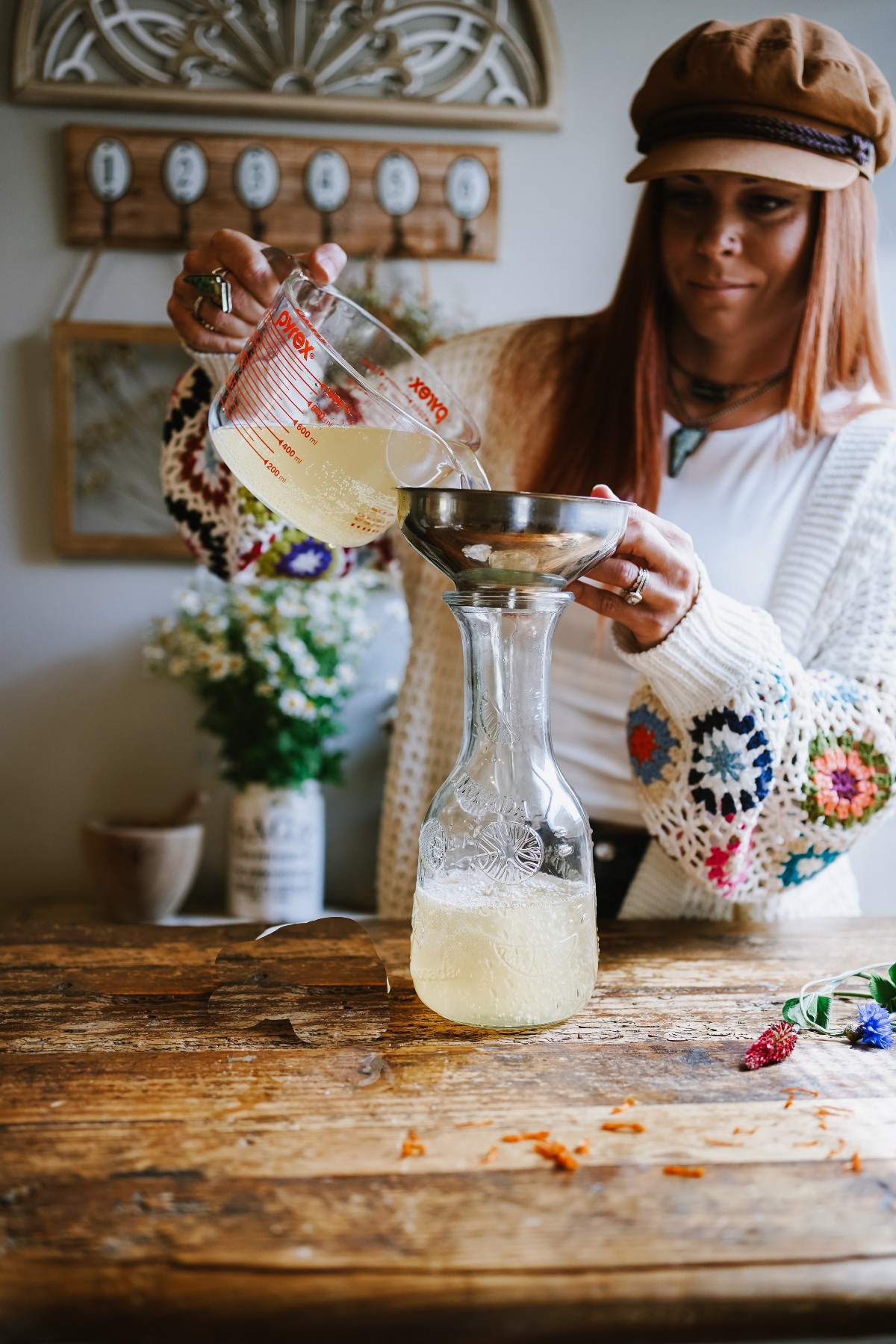
How to Make A Wildflower Cordial
Blooms and bubbles–a delightful spring experience awaits you via the fascinating method of fermentation. Wildflowers (or garden flowers!) and their accompanying unique wild yeasts are submerged into a bath of sugar water and, with a bit of time, the magic of fermentation yields a fizzy, delicious refreshment, perfect for sipping on the porch. Let’s make wildflower cordial!

Edible Flowers
Whether in fields or in the garden, flowers swing and sway in the breeze, their brightly colored petals bring so much joy, and in some cases, they are beautiful additions to our food!
Flowers can be used for cake and cookie decorating, colorful salad toppings, vinaigrette infusions, and in this recipe, a wildflower cordial.
While some flowers make excellent ingredients in cocktails, mocktails, salads, and desserts, others are more appropriately enjoyed for their visual beauty than eaten. Here is a short list of edible flowers to choose from for your next recipe:
- Blue cornflower (Centaurea cyanus)
- California poppy (Escholschzia californica)
- Calendula (Calendula officinalis)
- Chamomile (Matricaria chamomilla)
- Dandelion (Taraxacum officinale)
- Hibiscus (Hibiscus sabdariffa)
- Lavender (Lavandula spp.)
- Nasturtium (Tropaeolum majus)
- Pansy (Viola × wittrockiana)
- Rose (Rosa spp.)
- Rosemary (Salvia rosmarinus)
- Sourgrass (Oxalis pes-caprae)
- Violet (Viola spp.)

Using flowers in herbal food and beverage preparations is a fun way to discover what the flower has to offer. For instance, chamomile has a subtle, sweet taste, lending itself well to baked goods recipes, whereas Bermuda buttercups, a.k.a., sourgrass have a surprisingly sour taste to them. If you want to really punch up a recipe, add sourgrass! Nasturtiums have a spicy pepper-like flavor and taste so delicious in this infused vinegar dressing recipe. Mixing and matching flowers with a recipe is much like any recipe you whip up. You want a balance of flavors to complement the main ingredient.
With flower cordials, you can actually go a little wild—pun intended. The flowers for this recipe will influence the overall final taste, however the type(s) of flowers you use together is very flexible. Sugar water is the base of the recipe, therefore, your cordial will be a sweet treat no matter what flowers you choose—that said, microorganisms will break down some of that sugar during the fermentation process, reducing some of the sweetness.

Cordial-Making Process
A cordial by definition is an herbal drink made up of botanicals or fruit, sugar, water, and oftentimes alcohol. If a recipe calls for alcohol, you can omit the alcohol if preferred and play around with the different alternative methods to make a cordial, like we did in this recipe.
There are two methods to making a cordial: either it can be quick and instant with no fizz, or you can try your hand at wild fermentation and enjoy your sparkling cordial after a few days. For this recipe, we will be making a wild-fermented wildflower cordial (say that three times fast!). The extra fizz you get from the easy fermentation process is an even more enjoyable way to delight in the taste of this spring-inspired recipe.
The first step is to properly identify and gather edible wildflowers (or garden flowers). For this cordial recipe, you will need about one cup of flowers. Give them a good rinse to wash away dirt, debris, and little critters. Most cordials that undergo the fermentation process will require fresh flowers. This important factor is due to the need for the natural wild yeast that is found on the fresh botanical material. Wild yeast provides the food the sugar water needs to grow and fizz through microbial fermentation.

How Does Sugar Water And Flowers Turn Into A Fermented Fizzy Drink?
Fermentation is a process in which an organism (wild yeast), converts a carbohydrate (sugar), into carbon dioxide. It is also the same process for alcohol—and acid-based recipes. It is all about energy conversion—the yeast converts sugar to alcohol as a means of obtaining energy. This is known as fermentation (Maicas, 2020). Wild yeasts are particularly abundant in flower nectar, which provides the yeast needed for the fermentation process (Pozo et al., 2009).
Another important thing to note in the cordial making process is citric acid. This is used as a preservative and it is naturally found in lemons. Not only do lemons boost the bright flavor of the drink, but they also help to enhance the flavor of the flowers you use. Win-win—shelf life and flavor enhancer!
Now that you’ve gathered your edible flowers, you need to make the sugar water base. Much like a simple syrup, you want to use a 1:1 ratio—for every 1 measured amount of sugar, you will use equal amounts of water. This cordial recipe calls for 2 cups of sugar and 2 cups of water. Both of those go into a pan to heat up the water and dissolve the sugar. Once cooled, that sugar water is poured into a jar with the wildflowers and lemon slices.
Here comes the unique part–you don’t have to do anything else! Cover your jar with cheesecloth and rubber band or a lid not fully screwed on, and place the jar on your counter or a sunny windowsill for 3 days. Over the next few days, you will start to see tiny bubbles form at the top of the liquid. Those happy little bubbles are your sign that the fermentation is complete! The cordial is ready to be strained and enjoyed.
While this is a quick fermentation, the world of fermenting is a robust and unique study, and you can delve into that deeper here at Herbal Academy! Students from all over the world have enjoyed our Craft of Herbal Fermentation course.

How to Make a Wildflower Cordial
Wildflowers and wild fermentation come together to create a delicious and delightful spring-inspired refreshment. Sip on this wildflower cordial under the spring sun, or share with friends at your next gathering. It’s a unique flavor and tasting experience and easy to make!
1 cup edible wildflower variety (this recipe used: blue cornflower (Centaurea cyanus) aerial parts, sourgrass (Oxalis pes-caprae) aerial parts, California poppy (Escholschzia californica) aerial parts, calendula (Calendula officinalis) aerial parts, dandelion (Taraxacum officinale) flower, lavender (Lavandula spp.) flower bud, nasturtium (Tropaeolum majus) flower and leaf, and rosemary (Salvia rosmarinus) flower and leaf
½ organic lemon, sliced
2 cups organic cane sugar
2 cups spring water
- Gather fresh, edible flowers. Wash and pat dry.
- Slice organic lemon.
- In a medium saucepan, bring water and sugar to a boil. Stir until sugar dissolves. Turn off heat and let cool to room temperature.
- In a large glass jar, place flowers and lemon slices, then pour in sugar water.
- Cover loosely and place on the counter or sunny windowsill for 3 days.
- After the third day, tiny bubbles should form at the top of the liquid. If no bubbles have formed, you may need to feed the yeast more by adding a little more sugar. Wait another day to see if it bubbles up before you start the process over.
- Using a fine mesh strainer and cheesecloth, strain out the flowers.
- Store cordial in a glass jar with lid, keep in refrigerator for up to 1 month.
To Enjoy:
The wildflower cordial is a concentrated liquid that should be diluted down before sipping. Served best chilled, you can pour a shot glass worth into a glass and add water or sparkling water for an extra sip of fizz, or even enjoy your cordial in smoothies, juice, or cider.

In Closing,
You will love the unique tasting experience that a wildflower cordial offers. The sweetness, the various flavors from each flower, and the added touch that something homemade brings to any recipe—love! Happy sipping, friends. We hope you try this wildflower cordial recipe.

REFERENCES
Maicas, S. (2020). The role of yeasts in fermentation processes. Microorganisms, 8(8), 1142. https://doi.org/10.3390/microorganisms8081142
Pozo, M.J., de Vega, C., Canto, A., & Herrera, C.M. (2009). Presence of yeasts in floral nectar is consistent with the hypothesis of microbial-mediated signaling in plant-pollinator interactions. Plant Signaling & Behavior, 4(11), 1102–1104. https://doi.org/10.4161/psb.4.11.9874








